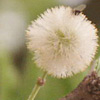Acacia elatior is a tall, evergreen, riverine tree, 7-40 m tall; crown rounded or flattish; bark brown, deeply fissured; stipular spines of 2 kinds in pairs at the nodes - shorter, 7 mm, brown, sometimes, curved spines, alternating with longer spines, which may reach 9 cm and are straight, white, with a swollen base; the larger spines are sometimes inflated to about 6 (max. 15) mm across; trunk is large, and young twigs are reddish-brown.
Leaves with 5-13 pairs of pinnae; leaflets in (min. 7) 13-25 pairs, 1.2-4 x 0.5-1.4 mm, small and narrow, glabrous or ciliate; petiole 3-10 mm; petiole and rachis glands absent.
Flowers in round heads, white to very pale yellow. Fruits are brown to purplish-brown pods, straight or slightly falcate, narrowly oblong, 3.5-12 x 1.2-1.8 cm, tapering at the tip, papery texture, dehiscent; seeds olive-brown, subcircular, 6-7 mm in diameter, thin, flattened.
Acacia elatior grows in the arid and semi-arid areas of Uganda, Sudan and Kenya at non-saline habitats, at altitude: 180-1100 m, and mean annual rainfall: 500-1200 m. It occurs on sandy river banks often in association with Acacia tortilis.
Acacia elatior is used in its native countries for various purposes; Fodder: pods and young shoots are browsed by livestock. Fuel: produces good firewood and charcoal. Timber: The Turkana of Kenya use the wood to make drinking vessels. Medicine: In Kenya a bark decoction is used to treat diarrhoea and gonorrhoea and as a remedy for coughs.
Written by Amram Eshel





